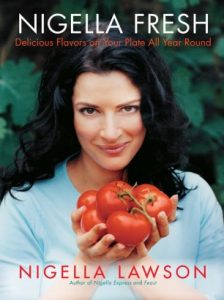Cookbooks could be a much better source of food safety information than they are. So could online recipes (like those from Epicurious, Allrecipes.com and foodnetwork.com.
Katrina reminded me today that those are next.
The NC State University press release on our cookbook paper came out today.
For Immediate Release
March 27, 2017
A recent study finds that bestselling cookbooks offer readers little useful advice about reducing food-safety risks, and that much of the advice they do provide is inaccurate and not based on sound science.
“Cookbooks aren’t widely viewed as a primary source of food-safety information, but cookbook sales are strong and they’re intended to be instructional,” says Ben Chapman, senior author of a paper on the work and an associate professor of agricultural and human sciences at North Carolina State University.
“Cookbooks tell people how to cook, so we wanted to see if cookbooks were providing any food-safety information related to cooking meat, poultry, seafood or eggs, and whether they were telling people to cook in a way that could affect the risk of contracting foodborne illness,” Chapman says.
To that end, the researchers evaluated a total 1,497 recipes from 29 cookbooks that appeared on the New York Times best sellers list for food and diet books. All of the recipes included handling raw animal ingredients: meat, poultry, seafood or eggs.
Specifically, the researchers looked at three things:
Does the recipe tell readers to cook the dish to a specific internal temperature?
If it does include a temperature, is that temperature one that has been shown to be “safe”? For example, cooking chicken to 165°F.
Does the recipe perpetuate food-safety myths – such as saying to cook poultry until the juices “run clear” – that have been proven unreliable as ways of determining if the dish has reached a safe temperature?
The researchers found that only 123 recipes – 8 percent of those reviewed – mentioned cooking the dish to a specific temperature. And not all of the temperatures listed were high enough to reduce the risk of foodborne illness.
“In other words, very few recipes provided relevant food-safety information, and 34 of those 123 recipes gave readers information that wasn’t safe,” Chapman says. “Put another way, only 89 out of 1,497 recipes gave readers reliable information that they could use to reduce their risk of foodborne illness.”
In addition, 99.7 percent of recipes gave readers “subjective indicators” to determine when a dish was done cooking. And none of those indicators were reliable ways to tell if a dish was cooked to a safe temperature.
“The most common indicator was cooking time, which appeared in 44 percent of the recipes,” says Katrina Levine, lead author of the paper and an extension associate in NC State’s Department of Agricultural and Human Sciences. “And cooking time is particularly unreliable, because so many factors can affect how long it takes to cook something: the size of the dish being cooked, how cold it was before going into the oven, differences in cooking equipment, and so on.”
Other common indicators used in the cookbooks included references to the color or texture of the meat, as well as vague language such as “cook until done.”
“This is important because cooking meat, poultry, seafood and eggs to a safe internal temperature kills off pathogens that cause foodborne illness,” Levine says. “These temperatures were established based on extensive research, targeting the most likely pathogens found in each food.”
A list of safe cooking temperatures can be found here.
“Ideally, cookbooks can help us make food tasty and reduce our risk of getting sick, so we’d like to see recipes include good endpoint cooking temperatures,” Chapman says. “A similar study was done 25 years ago and found similar results – so nothing has changed in the past quarter century. But by talking about these new results, we’re hoping to encourage that change.”
The paper, “Evaluating food safety risk messages in popular cookbooks,” is published in British Food Journal. The paper was coauthored by Ashley Chaifetz, a former Ph.D. student in Chapman’s group at NC State who now works for the U.S. Department of Agriculture’s Food and Nutrition Service. The work was supported by USDA’s National Institute of Food and Agriculture under grant number 2012-68003-30155.
Note to Editors: The study abstract follows.
“Evaluating food safety risk messages in popular cookbooks”
Authors: Katrina Levine and Benjamin Chapman, North Carolina State University; Ashley Chaifetz, U.S. Department of Agriculture
Published: March 17, British Food Journal
DOI: 10.1108/BFJ-02-2017-0066
Abstract:
Purpose: Medeiros et al. (2001) estimate 3.5 million cases of foodborne illness in the U.S. annually are associated with inadequate cooking of animal foods or cross-contamination from these foods. Past research shows home food handling practices can be risk factors for foodborne illness. The purpose of this study was to evaluate the communication of food safety guidance, specifically safe endpoint temperatures and cross-contamination risk reduction practices, in popular cookbook recipes.
Design/methodology/approach: Recipes containing raw animal ingredients in 29 popular cookbooks were evaluated through content analysis for messages related to safe endpoint temperature recommendations and reducing cross-contamination risks.
Findings: Of 1,749 recipes meeting study criteria of cooking raw animal ingredients, 1,497 contained a raw animal that could effectively be measured with a digital thermometer. Only 123 (8.2%) of these recipes included an endpoint temperature, of which 89 (72.3%) gave a correct temperature. Neutral and positive food safety behavior messages were provided in just 7.2% (n=126) and 5.1% (n=90) of recipes, respectively. When endpoint temperatures were not included, authors often provided subjective and risky recommendations.
Research limitations/implications: Further research is needed on the effect of these results on consumer behavior and to develop interventions for writing recipes with better food safety guidance.
Practical implications: Including correct food safety guidance in cookbooks may increase the potential of reducing the risk of foodborne illness.
Originality/value: Popular cookbooks are an underutilized avenue for communicating safe food handling practices and currently cookbook authors are risk amplifiers.



